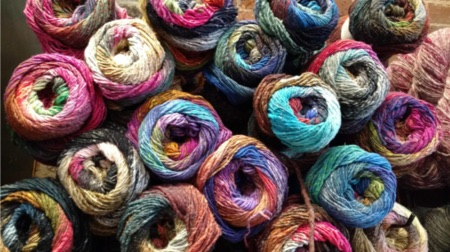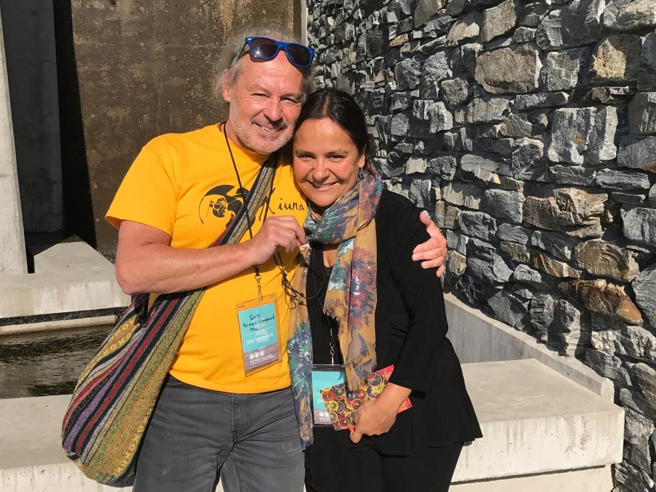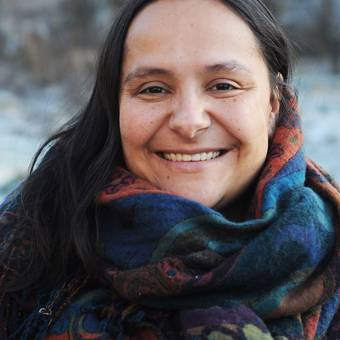 Vanessa Andreotti at a Conversation + Creations session
Vanessa Andreotti at a Conversation + Creations session
during the PC/Cp Gathering 2017 on Lekwungen territory.
Photo credit: Kirk Schwartz.
knitting needles
I was invited to lead a bilingual inter-generational conversation with Guy Sioui-Durand on the topic Re-Wilding Our Imaginations/Ré-ensauvagement de nos imaginaires. During the session, we talked about the potential of socially engaged art to interrupt the colonial entrapments of our imagination and to help us to heal the collective pain caused by enforced separations.
one wool yarn
My work in arts and education focuses on troubling the modern-colonial idea that being is reducible to knowing. I am interested in how art can enable us to tap a stream of connections not mediated by the known and the knowable:
where relationships are not dependent on meaning, knowledge or understanding;
where generosity, compassion and humility are not intellectual choices;
where we can take responsibility for being entangled within a wider metabolism, much larger than human embodied temporalities.
In educational and artistic practices, this moves the focus from the dimension of knowing and questions of representation towards the dimension of being and questions about the limits of representability.
basic stitches
During the conference, ideas of entanglement through the unknown and unknowable popped up at different points. I sensed it in Maikoiyo Alley-Barnes’ explanation that we are not separate, but continuous with each other. I saw it in Zab Maboungou’s embodied insistence that art is, and comes from, movement and vibration. I experienced it in learning from Elwood Jimmy, the practice of disciplined knitting as a basis for deep listening. I read it in Chris Creighton-Kelly’s and France Trépanier’s open invitation for participants to go beyond access and inclusion. I heard it in many silences and songs that were performed within and in-between bodies and spaces.
different fibers, different patterns
I also witnessed when this notion was confronted with different ideas about the importance of representation, pride and/or identity in historical struggles for recognition. This witnessing felt like sitting at the edge of a fault line where two different sensibilities meet on uneven grounds, and where there is only one inadequate common language to communicate across differences. I felt this fault line strongly in the conversations in my session with Guy, in the panel discussing where art practices come from with Zab, and in the moment participants were asked to represent being, place, time and space using only language.
more wool
These were important moments of difficulty, discomfort and deep learning, which I am very thankful for. We need more encounters and perhaps a new language that can bridge these and other fault lines we will find as we work together, individual and unique in one layer of being, but also inseparable in another.
…more knitting
These moments also inspired two events at the ArtsEverywhere Festival in Guelph in January 2018, one curated by Elwood Jimmy, and another by myself. Elwood’s session Braiding Infinity: Enacting Indigenous futures was a conversation with Shelley Niro, Billy-Ray Belcourt, and Nancy Rowe addressing hybrids of ancient and innovative practices around land-based learning, and communal living centring Indigenous thought, protocols and relationships to land. The session Meaning or Movement? Objects or Rhythm? with Zab Maboungou, Ashon Crawley, and Maikoiyo Alley-Barnes invited the audience to engage with a number of questions related to the implications of mobilizing art primarily through movement, rhythm and process, rather than meaning, fixed stories and finished objects.
…knitting-together
I offer the two key questions we addressed in the sessions as an open invitation to collective knitting practices:
What are ways of imagining and being become viable when art is able to interrupt our satisfaction with the modern-colonial (intellectual, affective, relational and performative) economies we are invested in? And what are the conditions that make this interruption possible?
 Guy Sioui Durand and Vanessa de Oliveira Andreotti
Guy Sioui Durand and Vanessa de Oliveira Andreotti

Vanessa de Oliveira Andreotti holds a Canada Research Chair in Race, Inequalities and Global Change at the Department of Educational Studies, University of British Columbia. Her teaching and research focus on analyses of historical and systemic patterns of reproduction of knowledge and inequalities and how these limit or enable possibilities for collective existence.